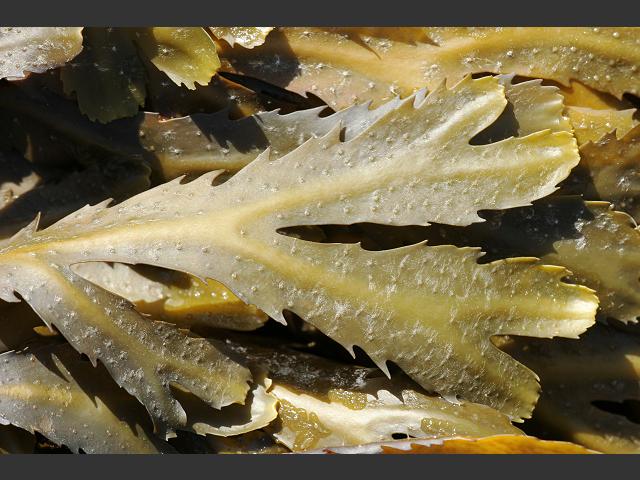
STAUROMEDUSAE UK
An online guide to the Stalked jellyfish (Stauromedusae) found
around the coastal waters of the United Kingdom and Ireland.
Includes notes on their identification, and where and how to find them.

Fucus serratus Linnaeus, 1753 - Saw, Saw-edged or Toothed wrack
Scroll down and rollover titles to change screen image or click on title to view image.
Saw or Toothed wrack
Fucus serratus
- frond tip 1
Fucus serratus
- frond tip 1
Saw or Toothed wrack
Fucus serratus
- fronds 1
Saw or Toothed wrack
Fucus serratus
- fronds 2
Saw or Toothed wrack
Fucus serratus
- frond close-up 1
Saw or Toothed wrack
Fucus serratus
- frond close-up 2
Saw or Toothed wrack
Fucus serratus
- holdfast 1
Saw or Toothed wrack
Fucus serratus
- on rocky middleshore 1
Saw or Toothed wrack
Fucus serratus
- on rocky middleshore 2
Saw or Toothed wrack
Fucus serratus
- on rocky middleshore 3
Saw or Toothed wrack
Fucus serratus
- on rocky middleshore 4
Saw or Toothed wrack
Fucus serratus
- on rocky middleshore 5
Saw or Toothed wrack
Fucus serratus
- on rocky middleshore 6
Saw or Toothed wrack
Fucus serratus
- on rocky middleshore 7
Saw or Toothed wrack
Fucus serratus
- on rocky middleshore 8
A species often commonly found on the middle and lowershore. Images take at various locations across Cornwall, including Spit Point, Par; Charlestown, near St. Austell; and Chiney Rocks, Penzance.
All references to Haliclystus here include Haliclystus auricula and Haliclystus octoradiatus. It is likely that both species can be found on Fucus serratus, although the author here would not regard Fucus serratus the best algae on which to find Haliclystus, especially in Cornwall.
In terms of the species being a suitable species for stauromedusae, it is included here as there are numerous historic reports of the species being important, both directly and indirectly.
I have included here two historic accounts that refer to Haliclystus on Fucus, the latter mentions Fucus serratus directly, and also reports that Haliclystus occurs on epiphtyes that are found on Fucus serratus.
The latter article states that epiphytes on which Haliclystus are found include Ceranium rubrum now C. virgatum and Rhodomela subfusca now Rhodomela confervoides.
On looking into Rhodomela confervoides I found the algae didn't exactly fit the profile, and consulted Professor Michael Guiry who very kindly gave me the following explaination.
Rhodomela confervoides, aka Rhodomela subfusca, occurs very rarely on larger seaweed, and then mostly on the stipes of Laminaria hyperborea in my experience; I have never seen it on Fucus serratus, but older plants of F. serratus often have Ceramium growths, like, as you say. C. virgatum / C. rubrum that is fully corticated and can look like Rhodomela.
He also kindly gave me a reason for the likely occasional occurence of Haliclystus on Fucus serratus.
"All but the older Fucus serratus plants shed their skins periodically like a snake. As the F. serratus plants age they lose the ability to shed their skins and also tend to produce less mucilage on the surface."
This suggests when stauromedusae may occur on Fucus serratus, and it would be interesting to gain further accounts of the status of Fucus serratus when stauromedusae are found on it. I have personally only found Haliclystus octoradiatus a couple of times on Fucus serratus and both times on damaged specimens.
Scientific and European Names:
Fucus serratus, Saw wrack, Serrated wrack, Toothed wrack, Sägetang, Gezaagde zeeëik, Fucus dentelé, Encina de mar dentada.
